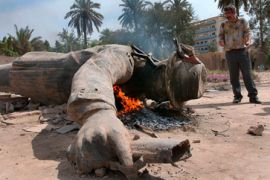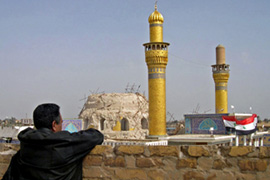Timeline: US in Iraq
A chronicle of US involvement in the Iraq war.

US military forces have been in Iraq for nearly three years and 10 months, fighting longer than they did in World War II but with only a fraction of the casualties.
Below is a brief overview of the US-led war timeline on Iraq:
|
|
|
A bomb attack destroyed the dome of a Shia |
March 20, 2003
The Bush administration, which had accused Iraq of possessing weapons of mass destruction and sought to portray its former government as a participant in the September 11, 2001, attacks, mounts a bombing campaign followed by a land invasion.
The US-led “coalition of the willing” notably includes British and Spanish forces, but the campaign does not win the approval of the UN.
April 9, 2003
US forces enter central Baghdad and topple a large statue of Saddam Hussein, the Iraqi president.
May 1, 2003
Bush declares from an aircraft carrier off the California coast, that major combat is over in Iraq.
August, 2003
A massive car bomb shatters the UN headquarters in Baghdad, killing the senior UN official in the country.
December, 2003
US forces capture Saddam near Tikrit.
March 2004
A series of devastating bomb attacks in Madrid lead Spain to pull its forces out of Iraq.
April 2004
US media show photographs taken by US military in the Abu Ghraib prison near Baghdad of Iraqi detainees being tortured by grinning Americans.
June 2004
An interim government is set up and the US authorities declare that Iraqis now enjoy sovereignty.
November 2004
More than 10,000 US soldiers backed by 2,000 Iraqi troops launch a massive attack on the city of Falluja.
January 2005
The US administration says it is giving up its search for weapons of mass destruction after having found none.
Nationwide elections for a transitional government give a large majority to Shia Muslim parties, but many Sunnis refuse to vote. Kurdish parties make a strong showing.
October 2005
A new constitution, approved by referendum, gives wide autonomy to the country’s regions, which critics see as a recipe for partition.
Saddam goes on trial for crimes committed during his rule.
December 2005
Parliamentary elections attract wide participation, and give victory to a Shia alliance.
February 2006
A bomb attack destroys the dome of one of the world’s most important Shia shrines, in Samarra, prompting widespread violence between Shia and Sunni Muslims.
June 2006
Abu Musab al-Zarqawi, a-Qaeda’s leader in Iraq, is killed in a US air strike.
October 2006
British study concludes that about 655,000 Iraqi civilians have died since the invasion.
November 2006
The Bush administration suffers a major political setback as congressional elections deprive it of its parliamentary majority.
A special tribunal sentences Saddam to death after the first in a series of several trials.
Amid widespread fighting, a single series of attacks kills more than 200 people in the Shia neighbourhood of Sadr City, Baghdad.
December 2006
Saddam is hanged. Videos showing him being taunted by his Shia guards are circulated on the internet.
January 2007
The number of US military dead passes the 3,000 mark.
Bush shakes up the military and political command of his Iraq operation before announcing a new strategy.
